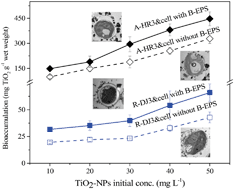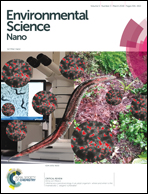Distinct effects of soluble and bound exopolymeric substances on algal bioaccumulation and toxicity of anatase and rutile TiO2 nanoparticles†
Abstract
Anatase titanium dioxide nanoparticles (TiO2-NPs) are generally observed to have a higher cellular toxicity than rutile TiO2-NPs, which is mainly ascribed to the increased generated amount of intracellular reactive oxygen species (ROS) and thereby the greater oxidative damage of anatase TiO2-NPs. However, close attachment between nanoparticles (NPs) and cells is a prerequisite for the inducement of intracellular ROS generation. Cell surface bound and soluble exopolymeric substances (B-EPS and S-EPS, respectively) can play an important role in the cell–NPs interaction and regulate the difference in the nanotoxicity of different NPs, which has not been specifically investigated. Interactions of S-EPS and B-EPS extracted from green algae (Chlorella pyrenoidosa) with anatase and rutile TiO2-NPs and the effect of EPS on the algal accumulation and toxicity of the NPs were therefore investigated. Results show that the anatase TiO2-NPs had a significantly higher adsorption of B-EPS than the rutile TiO2-NPs, which could contribute to the greater heteroagglomeration with the algae and the higher algal toxicity of the anatase TiO2-NPs. S-EPS had a higher adsorption on the two NPs than B-EPS; and the adsorption of S-EPS in the bulk solution increased homoaggregation and sedimentation of the NPs, which could inhibit the algal accumulation and toxicity of the NPs. The association with B-EPS greatly increased the apparent algal accumulation of the NPs, but the accumulated NPs could mainly be located on cell surfaces rather than entering the cells, as evidenced by the transmission electron microscopy observation. Thus, B-EPS could act as a bio-barrier protecting the cell wall and membranes from the direct attack of NPs and limiting the cell internalization of NPs. However, the algal cell associated NPs would transfer through food chains with algae, which could cause potential ecological effects and warrants further study. These results will be helpful for assessing the fate and ecological effects of NPs.



 Please wait while we load your content...
Please wait while we load your content...